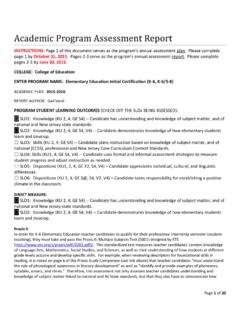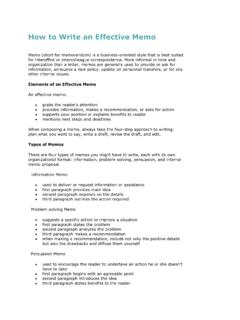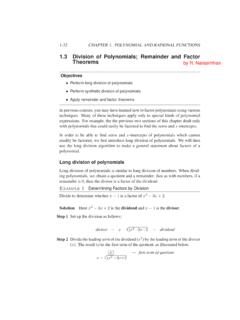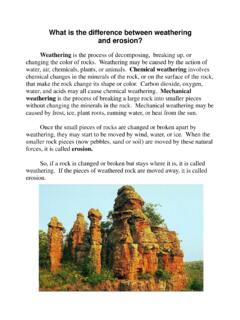Transcription of Slope Failure - Home | Kean University
1 Slope FailureIntroductionSlope Failure FactorsSlope Failure ProcessesSummaryThe whole black earth is oppressed beneath the storm .. all the riversflow in flood, and many hillsides are furrowed deeply by the torrents, andthey rush to the purple sea from the mountains, roaring mightily, and thefields of men are weathering can produce a thick mantle of unconsolidatedmaterial on slopes that may fail as a result of humanactivity or natural processes. Mass wasting is the downslope movement of materialunder the influence of gravity and mass wastingphenomena can be linked to weathering processes. Mass wasting processes may be slow and gradual or swiftand debris may collect on slopes or form new slopes inareas with relatively rapid weathering rates.
2 Thisunconsolidated material is susceptible to collapse resulting inslope Failure . The downslope movement of material under theinfluence of gravity is termed mass wasting and represents oneof the most active processes in modifying the landscape inareas of significant relief (Fig. 1). Mass wasting involvesmaterial other than weathered debris (notably in rock slides)but most mass wasting phenomena occur in a thick mantle ofregolith, the rock and mineral fragments produced byweathering. The general term landslide is used to describe allrapid forms of mass national map of mass wasting activity ( ) shows areas with greatest potential for landslides andother Slope Failure events (in red and pink colors).
3 The areas atgreatest risk are in mountainous regions (Fig. 2) with relativelysteep slopes such as the Appalachians, Rockies, and mountainranges of California. Figure 1. Steepterrain withsignificant relief(change inelevation) suitablefor Slope Failure inthe BeartoothMountains,southern , the potential for mass wasting is not determined byslope angle alone. For example, we might expect the greatesthazards to be associated with the highest peaks in westernstates. However, the largest area at risk from landslides is inthe eastern Appalachian states. Water plays a significant rolein mass wasting and is much more plentiful in the eastern in the West (with the exception of the Pacific Northwest).
4 Finally, miscellaneous factors such as earthquakes, thepresence or absence of vegetation, and human activities canalso influence the potential for mass wasting (Fig. 3). In thenext section we consider the factors affecting Slope Failure ,including Slope angle and the presence of water. We will alsodiscuss how we can attempt to prevent such hazards bystabilizing slopes. Mass wasting processes may be slow and gradual or swift anddeadly. The final section in this part of the chapter describes aclassification system for mass wasting 2. relief and browncolors show areasof higher areas of highrelief in the westernstates and along thenortheast trendingAppalachianMountains in 3.
5 The resultof a landslidetriggered by the1994 Northridgeearthquake,southern steephillsides collapseddestroying courtesy ofUSGS Failure Factors Gravity can be divided into components acting parallel to aslope and perpendicular to the Slope . Failure is more likely to occur if the effect of friction on thepotential sliding surface is reduced. The physical properties of the Slope materials such ascohesion between grains may reduce the potential for slopefailure. The angle of repose is the maximum Slope generated whenloose unconsolidated material is formed into a pile. The addition of excess water may destabilize slopes byadding weight, destroying cohesion between grains, andreducing acts on all objects on Earth s surface.
6 Gravity can bedivided into two components for objects resting on slopingsurfaces (Fig. 4). One component is parallel to the Slope (gs)and one is perpendicular to the Slope (gp). On steep slopes (>45degrees) the component parallel to the Slope will be greatestand will act to pull objects downhill. On gentle slopes thecomponent perpendicular to the Slope will be greatest and willact to hold the object in , gravity alone does not determine if the object willmove downslope. There are numerous steep slopes that are notcurrently undergoing mass wasting. A physical trigger is oftenrequired to initiate Slope properties of the surface between the object and the Slope ( , friction) and the physical properties of the sliding objectitself all contribute to the potential for mass wasting.
7 Theobject is more likely to move if friction between the object andthe Slope is reduced. In contrast, a Slope will be less likely tofail if the cohesion between the grains in the material isFigure ofgravity orientedparallel (gs) andperpendicular (gp)to the Slope forgentle and steepslopes5increased. For example, no matter how much dry sand is addedto a pile, it can never form a Slope that is steeper than 35degrees inclination. This angle is termed the material s angleof repose. In contrast, by adding a little water, the cohesionbetween the sand grains (surface tension) increasesdramatically allowing us to sculpt sand castles with verticalwalls.
8 Irregularly shaped objects may form steeper slopes thandry sand; large angular blocks may have an angle of repose ofaround 45 degrees. In contrast, spherical marbles are almostimpossible to form into a pile with sloping addition of excess water to a Slope may also be theprecursor for a disaster. Not only does excess water saturate thematerial and reduce cohesion between grains but water-saturated pore spaces will support the weight of overlyingmaterial thus reducing the effect of friction. Finally, theaddition of water may promote instability by adding weight toa addition of extra weight to a Slope may be attributed tonatural processes ( , rainfall) but may also be the result ofhuman activity that adds water to the Slope ( , leaking septicsystems, overzealous irrigation) or adds new , human activity such as logging may removevegetation that shelters the Slope and provides a network ofroots to hold Slope material in place.
9 Over 100 people werekilled when devastating mudslides destroyed parts of twoItalian villages in May 1998. The mudslides followed heavyFigure 5. Two viewsof a landslide areain southwestMontana before andafter supports wereadded to the roadabove the slide areaand the slide areawas graded toreduce risk of futuremass wasting6rains and were blamed on poor land management practices,including deforestation of SlopesOne obvious solution to the problem of landslides is to avoidbuilding structures on steep slopes. However, such pragmaticadvice may not deter a homeowner in search of a spectacularview and is of little use to engineers who must build roads onsteep slopes in mountainous terrain (Fig.)
10 5). Instead, effortsfocus on improving Slope drainage (to reduce the role of water)or attaching the Slope material to bedrock with physicalrestraints. Such restraints may be as mundane as covering slopematerial with chicken wire or cement, or bolting rock panels tothe underlying bedrock (Fig. 6).The Beartooth highway climbs up the side of the BeartoothMountains, Montana (Fig. 7). The route connects the northeastentrance to Yellowstone National Park (Wyoming) with thecity of Red Lodge, Montana. Persistent Failure of the steepslopes requires that the road be repaired every few , efforts to prevent mass wasting have involvedsupporting the base of the Slope to prevent it from failing ( ).









